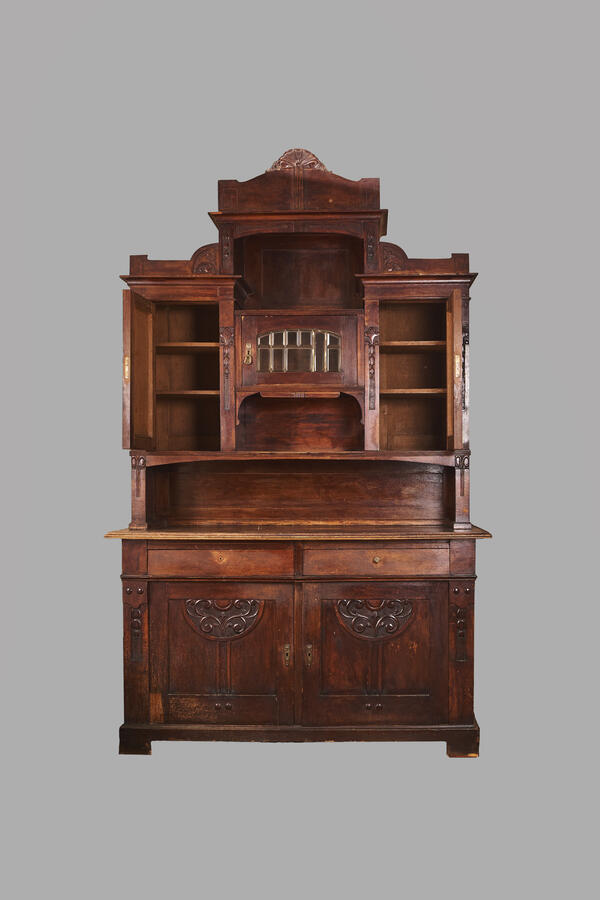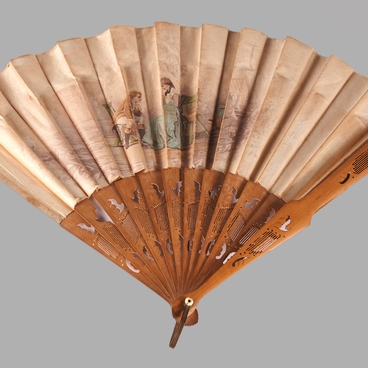This cabinet occupies most of the space in the “Room of Peasant Settlers”.
It was not until the 19th century — the first half of the 20th century that Russian peasants began to use this piece of furniture. The villagers had low cabinets, corner cabinets, sideboards, and chests of drawers, but the two-tiered cabinet was the most common one, a kind of a house itself. Its design resembled that of a building, and carpenters endowed it with classical architectural elements: columns, pilasters, niches, and cornices.
Back in the 17th century, two-tier cupboards began to look like they do today: the upper shelves were used for glassware and crystal dishes, drawers — for metal cutlery, and massive lower shelves with doors — for heavy porcelain and metal utensils, such as plates, dishes, bowls, teapots, etc. A counter with a niche separated the cabinet’s lower and upper parts. This design turned out to be one of the “timeless” ones overcoming modernization, changing eras and tastes, remaining untouched by time. It was convenient to prepare crockery and cutlery on the counter before taking them to the table.
In Russia, cabinets were used to store expensive tableware, as well as family heirlooms and sweet foods: candies, honey, jam, and pies. Over time, the cabinet became the center of the family’s wealth.
The Novorossiysk Museum-Reserve purchased this wooden cabinet from a resident of the city, V.V. Mamontova, in 1986. The cabinet was made in the late 19th — early 20th century. There is an arched pediment above the cornice of the central section protruding at the top. It has a carved finial in the form of an Art Nouveau multi-petal flower. The arched motif is repeated in the frieze and decor of the lower open shelf and niche, and the middle shelf has an arched beveled glass door. The cornices of the side sections are decorated with a carved ornament, and the doors are made of solid wood. The main decoration motif — tulips and plants with undulating stems and leaves — is typical for the style of Art Nouveau. All panels, planks and cornices at the top and bottom are decorated with low-relief carved patterns.
It was not until the 19th century — the first half of the 20th century that Russian peasants began to use this piece of furniture. The villagers had low cabinets, corner cabinets, sideboards, and chests of drawers, but the two-tiered cabinet was the most common one, a kind of a house itself. Its design resembled that of a building, and carpenters endowed it with classical architectural elements: columns, pilasters, niches, and cornices.
Back in the 17th century, two-tier cupboards began to look like they do today: the upper shelves were used for glassware and crystal dishes, drawers — for metal cutlery, and massive lower shelves with doors — for heavy porcelain and metal utensils, such as plates, dishes, bowls, teapots, etc. A counter with a niche separated the cabinet’s lower and upper parts. This design turned out to be one of the “timeless” ones overcoming modernization, changing eras and tastes, remaining untouched by time. It was convenient to prepare crockery and cutlery on the counter before taking them to the table.
In Russia, cabinets were used to store expensive tableware, as well as family heirlooms and sweet foods: candies, honey, jam, and pies. Over time, the cabinet became the center of the family’s wealth.
The Novorossiysk Museum-Reserve purchased this wooden cabinet from a resident of the city, V.V. Mamontova, in 1986. The cabinet was made in the late 19th — early 20th century. There is an arched pediment above the cornice of the central section protruding at the top. It has a carved finial in the form of an Art Nouveau multi-petal flower. The arched motif is repeated in the frieze and decor of the lower open shelf and niche, and the middle shelf has an arched beveled glass door. The cornices of the side sections are decorated with a carved ornament, and the doors are made of solid wood. The main decoration motif — tulips and plants with undulating stems and leaves — is typical for the style of Art Nouveau. All panels, planks and cornices at the top and bottom are decorated with low-relief carved patterns.


